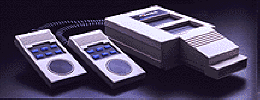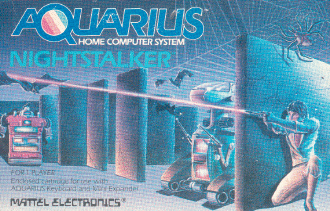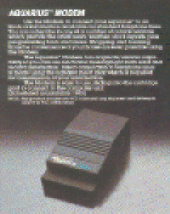
HISTORY OF HOME AND GAME COMPUTERS

| Navigator | ||||||||||||||||||
|
|
|
|
||||||||||||||||
|
|
||||||||||||||||||
|
Aquarius was the
invention of Radofin The
company in Hong Kong still trusted in the success of its computers.
Radofin announced the launch of the Aquarius II in March 1984 and promised
an Aquarius III for July 1984. Radofin kept manufacturing the Aquarius I
until 1988.
|
|
Many prototypes
Other examples of Aquarius extensions hardly or not available are a modem (also in the shape of a cartridge, see the picture from my Aquarius catalogue) and a four-colour-printer.
|
Welcome to the nostalgic
history of home and game computers

Mattel Aquarius - home computer with the shortest career
 The
success of home computers in the early eighties made manufacturers eager. Mattel,
famous because of its Barbie dolls, also wanted to profit from the boom in home computer business. But Mattel didn't profit at all: the company in 1983 became
responsible for one of the biggest failures in de history of home
computers.
The
success of home computers in the early eighties made manufacturers eager. Mattel,
famous because of its Barbie dolls, also wanted to profit from the boom in home computer business. But Mattel didn't profit at all: the company in 1983 became
responsible for one of the biggest failures in de history of home
computers.
It wasn't strange that Mattel decided to develop home computers too. The
division Mattel Electronics had achieved much success with the game console
Intellivision. A special keyboard was developed, with which the Intellivision
could be metamorphosed into a (sort of) home computer. But now Mattel
Electronics wanted to develop a computer that could stand on its own.
Less then 20,000 Aquarius computers sold
It became the Mattel Aquarius, with its characteristic blue
rubber keys and water resistant appearance - Mattel didn't belie its toy-nature.
The Aquarius should compete in the market segments then controlled
by the Texas Instruments TI 99/4A, the ZX-81 and ZX Spectrum, the Oric and the
VIC-20. But instead of that, it turned out into a terrible failure: Mattel began
manufacturing the Aquarius in June 1983 and already stopped with it in October
1983! Estimations are that worldwide less then 20,000 Aquarius computers were sold, while Mattel had expected to sell 100,000. Of course, this makes the
Aquarius very interesting for today's collectors.

Causes of failure |
Expensive extensions
Indeed, the Aquarius had 4K of RAM at its disposal, but in fact the consumer
could only use 1,7 K. Needless to say that this amount of RAM was fairly
useless. In this way, working with the word processor Fileform which Mattel sold
on a cartridge, was almost impossible. Unless the user was prepared to store
paragraphs again and again on tape or print them on paper.
In an attempt to compensate this, Mattel Electronics sold various comparatively
expensive extension options. Examples are the 4K and 16 K RAM memory expansions;
cartridges which could be plugged into the Aquarius. Besides that, there was the
so-called Mini Expander that could be attached to the computer. With the Mini
Expander - almost taller then the tender Aquarius itself - you could use two
cartridges at the same time (e.g. RAM-extension and a game). It gave the
Aquarius also two extra sound channels and two Intellivision-like controllers for
playing games.
 Extra
costs Extra
costsAs a consequence the consumer who thought to have bought a relatively cheap home computer and game console, was confronted afterwards with many extra costs. And paid much more than his neighbour who had bought a ZX Spectrum. Employees of Mattel Electronics later confessed that this was part of the selling strategy: selling the Aquarius itself with losses, and make profit on the extension options and games. |
|
Basic without FOR and NEXT
The Aquarius was equipped with a 'diet-version'
of Microsoft Basic. If you wanted to use such common commands as FOR and
NEXT, you had to buy yet another cartridge: Extended Microsoft Basic. IF
you could get this cartridge: I doubt whether it ever appeared on the
shelves in large numbers. I even read that Microsoft Extended Basic for the
Aquarius never went beyond the prototype status, although I have the
cartridge in my collection. |
Specifications of the Mattel Aquarius
| Manufacturer | Mattel |
| Period | June - October 1983, afterwards by Radofin until 1988 |
| CPU | NEC D780C; sometimes equipped with a real Z80 |
| Frequency | 3,5 MHz |
| ROM | 10 KB |
| RAM | 4 KB (in fact only 1,7 KB
available) expandable with cartridges |
| Text mode | 24 lines x 40 columns |
| Graphical mode | 80 x 72 pixels |
| Colours | 16 |
| Sound | 1 channel, 2 extra with Mini Expander |
| I/O | TV, cassette, printer, cartridge |
| Price | Approx. 150 dollar 225 guilders according to the sticker on my Aquarius |
| News | |||
|
|
|
|
|
|
|
|||
View results from last poll:
how many games you have? (3127
votes)



